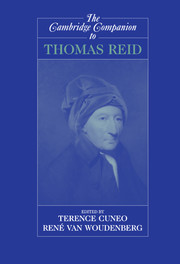Book contents
- Frontmatter
- Introduction
- 1 Reid in Context
- 2 Thomas Reid and the Culture of Science
- 3 Reid on Common Sense
- 4 Reid’s Theory of Perception
- 5 Reid’s Reply to the Skeptic
- 6 Nativism and the Nature of Thought in Reid’s Account of Our Knowledge of the External World
- 7 Reid and the Social Operations of Mind
- 8 Reid on Memory and the Identity of Persons
- 9 Thomas Reid’s Theory of Freedom and Responsibility
- 10 Reid’s Moral Philosophy
- 11 Reid’s Philosophy of Art
- 12 Reid’s Philosophy of Religion
- 13 Reid’s Influence in Britain, Germany, France, and America
- Bibliography
- Index
11 - Reid’s Philosophy of Art
Published online by Cambridge University Press: 28 May 2006
- Frontmatter
- Introduction
- 1 Reid in Context
- 2 Thomas Reid and the Culture of Science
- 3 Reid on Common Sense
- 4 Reid’s Theory of Perception
- 5 Reid’s Reply to the Skeptic
- 6 Nativism and the Nature of Thought in Reid’s Account of Our Knowledge of the External World
- 7 Reid and the Social Operations of Mind
- 8 Reid on Memory and the Identity of Persons
- 9 Thomas Reid’s Theory of Freedom and Responsibility
- 10 Reid’s Moral Philosophy
- 11 Reid’s Philosophy of Art
- 12 Reid’s Philosophy of Religion
- 13 Reid’s Influence in Britain, Germany, France, and America
- Bibliography
- Index
Summary
I must begin by stating emphatically what my subject is not. My subject is not the aesthetics of Thomas Reid: It is his philosophy of art.
By “aesthetics” I understand that branch of philosophy that deals with a wide, not clearly demarcated range of familiar questions, among which are the subset of questions that have specifically to do with the nature of the fine arts, their relevant qualities, and our interactions with them either as artists, critics, or audience. Philosophers, since and beginning with Plato, have written in a philosophical vein about what we would recognize as art and the aesthetic. But for some well-known reasons that I will adduce in a moment, no philosopher, before the eighteenth century, can really be said to have had a philosophy of art. Furthermore, even in the eighteenth century, to have a philosophy of art was an uncommon thing. And if Reid did have one, it would put him in the company of a very small group, perhaps consisting only of Alexander Baumgarten and, of course, Immanuel Kant. It would put him in the company of the pioneer philosophers of art. That Reid was of this number – or, at least, that he came very close to being – is the argument of this chapter.
- Type
- Chapter
- Information
- The Cambridge Companion to Thomas Reid , pp. 267 - 288Publisher: Cambridge University PressPrint publication year: 2004
- 4
- Cited by



